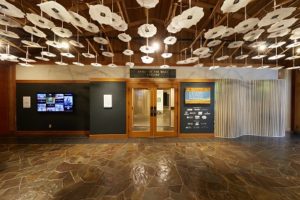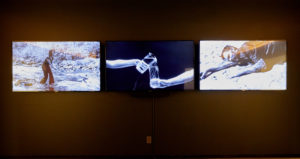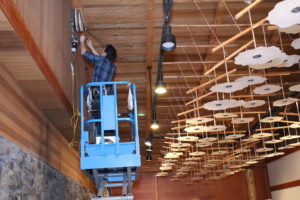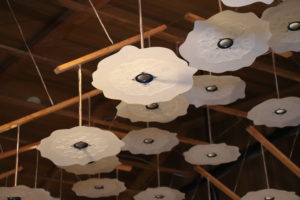 If you visit the Museum this summer, you’ll get the opportunity to explore the original exhibit Desert Reflections: Water Shapes the West. The dynamic, multifaceted exhibition weaves together science, history, art and contemporary issues in its examination of the role of water in the region’s past, present and future.
If you visit the Museum this summer, you’ll get the opportunity to explore the original exhibit Desert Reflections: Water Shapes the West. The dynamic, multifaceted exhibition weaves together science, history, art and contemporary issues in its examination of the role of water in the region’s past, present and future.
In addition to the discussion of the complexities of water management, Desert Reflections connects visitors to its significance through visual art, music and spoken word performances. The High Desert Museum commissioned artwork from four Pacific Northwest artists for the exhibition. The project began with field trips into the desert with experts in order to spark discussion and inspiration for the pieces.
One of the four artists on the journey is Eugene’s art collective Harmonic Laboratory. The group created two installations for the exhibition. These are their stories.
Garden of Earthly Delights
 When you enter the Spirit of the West Gallery, the main location of Desert Reflections, walk to the back of the room and you’ll find the haunting video triptych Garden of Earthly Delights. Three large flat screen televisions are arranged in a horizontal row, each displaying discrete black-and-white videos.
When you enter the Spirit of the West Gallery, the main location of Desert Reflections, walk to the back of the room and you’ll find the haunting video triptych Garden of Earthly Delights. Three large flat screen televisions are arranged in a horizontal row, each displaying discrete black-and-white videos.
Garden of Earthly Delights depicts a loss of innocence, making deliberate reference to Hieronymus Bosch’s iconic triptych by the same title, created in the late 15th century. The original imagery reflects biblical scenes read from left to right; Eden, the Judgment, and Hell. Bosch’s triptych stands as a warning against the devastating outcome of irresponsibility and self-interest. The imagery used in the Harmonic Laboratory video version follows the same basic narrative, but is more political in nature, representing the tension between two bodies of diverse backgrounds engaged in a negotiation over water as a scarce and precious resource.
Observing the panels from left to right, the first screen situates an Indigenous woman emerging from a pristine river surrounded by a lush forest. The center panel zooms in on the two central figures’ hands pouring water back and forth between clear vessels. In the final screen a white male collapses onto the dry, cracked surface of a High Desert wasteland.
Garden of Earthly Delights uses two natural High Desert settings representing either an abundance of water or an extreme lack thereof. The protagonists reflect the socio-political tension between two groups in conflict over water rights: the Native peoples who have inhabited the area since time immemorial as riparian civilizations with deeply ancestral and spiritual ties to the water supply, and the white settlers who have journeyed west over the past two centuries to establish their homes and industries. This is a cautionary tale of the ultimate price of exploitation.
Awash
 Floating above one’s head more than 8 feet from the ground, Awash creates an array of sonic and visual movement. The piece runs 32’ along the Museum hallway, and the viewer walks underneath a 120-speaker network. As sound moves across the speakers, the installation physically moves up and down in one large sinusoidal wave via Dacron string connected to a large rotating disc. The disc connects to 20 rows of speakers, translating rotary motion into smooth vertical movement.
Floating above one’s head more than 8 feet from the ground, Awash creates an array of sonic and visual movement. The piece runs 32’ along the Museum hallway, and the viewer walks underneath a 120-speaker network. As sound moves across the speakers, the installation physically moves up and down in one large sinusoidal wave via Dacron string connected to a large rotating disc. The disc connects to 20 rows of speakers, translating rotary motion into smooth vertical movement.
Awash depicts the life, color and environment of the High Desert in a network of sound and moving parts. The kinetic sound sculpture emanates sonic shades of the High Desert while simultaneously flowing as a connected sinusoidal wave spanning 32 feet. The work hovers above the viewers’ heads and envelops them in sight and sound.
The soundscape in Awash has three types of audio: wind, water and color. For these three archetypal sounds, there are two audio modes. These modes either immerse the listener or move sound across the 32-foot structure. To help situate the listener within the High Desert, the piece amplifies field recordings of High Desert wind and Oregon waterways. The outside is brought inside, and across the length of the speaker array, viewers are enveloped in sounds that move above, through and around them. For sounds of color, a recording of a Skinner church organ, played by slowly adding keys and organ stops, creates lush, harmonic textures. These textural colors evoke the richness of the High Desert, a place that is shaped by multiple forces interacting in complex ways.
Unpacking the technical and mechanical design of Awash parallels understanding the symbiotic and complex forces at play in the water cycle of the High Desert. Ten electrical boards rest atop the structure, driving how sounds move. The boards are synchronously timed to trigger spatialized sounds across the structure. Standing underneath, one can hear and feel how natural forces move around us –– sounds of water and wind flow uninterrupted –– absorbed only by what is present within the space. The energy of sound is acoustically absorbed by bodies and materials in the museum, akin to the way that natural resources are consumed and absorbed within an ecosystem.
 Sound waves propagate throughout the space and undulating kinetic motion immerse the viewer. Light shimmers off tessellating shapes hanging midair, evoking an environment teeming with life and motion. Like scales from fish or rings of a tree, the piece marks the shape of a body inside a living ecosystem. Awash is made up of small pieces; yet, the individual components connect to form a mass that has weight.
Sound waves propagate throughout the space and undulating kinetic motion immerse the viewer. Light shimmers off tessellating shapes hanging midair, evoking an environment teeming with life and motion. Like scales from fish or rings of a tree, the piece marks the shape of a body inside a living ecosystem. Awash is made up of small pieces; yet, the individual components connect to form a mass that has weight.
Awash mirrors the distribution of energy within an ecosystem. In the High Desert, floodplains provide an energy buffer that supports the productivity and sustainability of life, in particular fish populations. The kinetic sound sculpture disperses sound energy across 120 3-watt speakers. As sound moves over longitudinal and lateral planes, the space becomes “awash” with varying frequencies and amplitudes. No one speaker is loud enough to cut through the ambient noise of the environment, but together, the distributed energy of the speaker network moves sound as large, vibrational waves across the constructed landscape of the Museum.
Experience Desert Reflections: Water Shapes the West and let Harmonic Laboratory’s installations wash over you. Desert Reflections is on display through Sunday, September 29, 2019.
